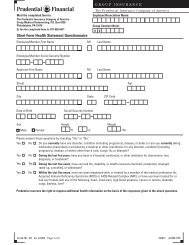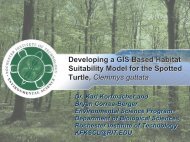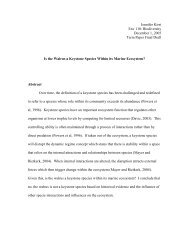Waste Water Treatment in Geneva, New York: - Hobart and William ...
Waste Water Treatment in Geneva, New York: - Hobart and William ...
Waste Water Treatment in Geneva, New York: - Hobart and William ...
Create successful ePaper yourself
Turn your PDF publications into a flip-book with our unique Google optimized e-Paper software.
SENIOR INTEGRATIVE EXPERIENCE, FALL 2010<strong>Waste</strong> <strong>Water</strong> <strong>Treatment</strong> <strong>in</strong><strong>Geneva</strong>, <strong>New</strong> <strong>York</strong>:The consequences on human life <strong>and</strong> theenvironment<strong>William</strong> Greer <strong>and</strong> Jacob Schreiber12/13/2010Our fresh water supplies are rapidly becom<strong>in</strong>g damaged <strong>and</strong> yet our practices have not significantlychanged <strong>in</strong> years. <strong>Waste</strong>water treatment, while a necessary for everyday life, is a process that has yet tobe perfected. While we need clean water, the process which provides us with this resource is actuallypollut<strong>in</strong>g the water body from which the water was <strong>in</strong>itially taken. Look<strong>in</strong>g specifically at Seneca Lake <strong>in</strong><strong>Geneva</strong>, <strong>New</strong> <strong>York</strong>, this paper will exam<strong>in</strong>e, <strong>in</strong> detail, the wastewater treatment process, theconsequences, <strong>and</strong> evaluate some alternative methods.
Introduction<strong>Waste</strong>water treatment is a key process <strong>in</strong> provid<strong>in</strong>g cities <strong>and</strong> the surround<strong>in</strong>g areas withsafe, sanitary water for municipal uses. The contents of wastewater, also known as sewage, are“99.94 percent water with only 0.06 percent of the wastewater be<strong>in</strong>g dissolved <strong>and</strong> suspendedsolid material.” 1 Despite our need for clean water, this process is far from perfect. Manychemicals go untreated <strong>and</strong> some are even created from the treatment of waste water. Even withthese imperfections there rema<strong>in</strong>s a lot of controversy over the <strong>in</strong>consistent regulation of thewastewater treatment process. Often times there are large disparities between fund<strong>in</strong>g of plants<strong>in</strong> different areas. While the government does regulate the chemicals released, the restrictionssometimes do not take <strong>in</strong>to account the effects that even m<strong>in</strong>or changes <strong>in</strong> concentrations canhave on ecosystems. Aquatic ecosystems such as Seneca Lake <strong>and</strong> the surround<strong>in</strong>g streams aresubject to any change <strong>in</strong> chemical concentrations from anthropogenic sources, which can causeimmense damage to these fragile ecosystems. Constant monitor<strong>in</strong>g is extremely importantbecause we utilize these water bodies for dr<strong>in</strong>k<strong>in</strong>g purposes as well as many other vital activities.Our goal is to determ<strong>in</strong>e whether or not phosphates be<strong>in</strong>g released from wastewater treatmentplants with<strong>in</strong> the Seneca Lake watershed have a direct affect on the aquatic ecosystem <strong>and</strong> thesource of dr<strong>in</strong>k<strong>in</strong>g water for the local population.1 http://ohiol<strong>in</strong>e.osu.edu/aex-fact/0768.html3 | P age
Background InformationUntil the early 1700’s, waste was be<strong>in</strong>g dumped uncontrollably <strong>in</strong>to local waterways,fields, <strong>and</strong> virtually anywhere people felt compelled to dispose of their effluent. In the mid-1700’s Benjam<strong>in</strong> Frankl<strong>in</strong> <strong>and</strong> others began to urge the Pennsylvania Assembly to regulate thedisposal of waste to prevent the contam<strong>in</strong>ation of local waterways. By the late 1800’s theconcept of sewer systems was beg<strong>in</strong>n<strong>in</strong>g to emerge lead<strong>in</strong>g to some major U.S. cities enact<strong>in</strong>gplans to control the release of municipal waste. F<strong>in</strong>ally <strong>in</strong> the early 1900’s, U.S. cities, generallywith populations over 4,000 persons, began establish<strong>in</strong>g basic sewer systems. After this Federal<strong>in</strong>volvement began to <strong>in</strong>crease with the establishment of pollution surveys of streams <strong>and</strong>harbors <strong>in</strong> 1914. These surveys revealed the damages from the dump<strong>in</strong>g of oil, untreatedmunicipal waste, <strong>in</strong>dustrial waste, <strong>and</strong> m<strong>in</strong>e runoff. It took nearly twenty years before the firstsewage treatment plant was m<strong>and</strong>ated; <strong>in</strong> 1933 the government declared that wastewater must betreated prior to its release <strong>in</strong>to the Mississippi River.<strong>Waste</strong>water “is released by residences, bus<strong>in</strong>esses, <strong>and</strong> <strong>in</strong>dustries <strong>in</strong> a community.” 1Ourstudy of the wastewater treatment process is based upon the treatment system utilized at theMarsh Creek <strong>Treatment</strong> Plant <strong>in</strong> <strong>Geneva</strong>, <strong>New</strong> <strong>York</strong>. The waste water treatment process variesfrom between different plants but it can be generalized <strong>in</strong>to a few ma<strong>in</strong> processes. (Image)<strong>Treatment</strong> beg<strong>in</strong>s when water from a s<strong>in</strong>k, toilet, sewer, or any other source enters a vast pipesystem that leads to a specified treatment center. Primary wastewater treatment beg<strong>in</strong>s withwater enter<strong>in</strong>g the plant where the water velocity is reduced to promote the separation of thedense materials from the light materials. With<strong>in</strong> the first aeration tank the dense materials s<strong>in</strong>kto the bottom as sludge <strong>and</strong> the lighter materials float to the surface <strong>and</strong> are skimmed off. It isestimated that this step alone removes approximately 40 percent to 60 percent of the suspended4 | Page
Data Analysis<strong>Water</strong> quality data has been compiled from Seneca Lake <strong>and</strong> the many streams that feed<strong>in</strong>to it for over a decade now. The collection of this data has helped to monitor, ma<strong>in</strong>ta<strong>in</strong>, <strong>and</strong>protect the health of our lake. Phosphate concentrations <strong>in</strong> Seneca Lake have been a focal po<strong>in</strong>tfor discussion on the health of the lake for many years now. Upon the breakdown of organicmaterial by bacteria, phosphates are formed <strong>and</strong> thus released <strong>in</strong>to the water as result of thisprocess. Most decomposition occurs along the lake floor, the sediments can thus pose a seriousthreat to the health of a lake. In an oligotrophic or healthy lake, there is a layer of oxygen thatacts as a cap <strong>and</strong> traps most of the phosphates with<strong>in</strong> the sediments. Eutrophic lakes are anoxic<strong>and</strong> thus there is no oxygen layer to cap the sediment based phosphates so they can openly enterthe water column. This load<strong>in</strong>g from the sediments is known as <strong>in</strong>ternal load<strong>in</strong>g. Oncephosphates enter the water column they are extremely difficult to disperse because algae rapidlytake <strong>in</strong> the excess nutrients. Phosphates never become toxic <strong>in</strong> excess levels, so algae can freelyconsume <strong>and</strong> store phosphates until they need it for various life functions. Algal ability toconsume <strong>in</strong>f<strong>in</strong>ite amounts of phosphates is known as luxury consumption.The ability for algae to practice luxury consumption with phosphates makes the dangersof phosphate load<strong>in</strong>g even more pert<strong>in</strong>ent. Over the past decade, water quality <strong>in</strong> Seneca Lake<strong>and</strong> its surround<strong>in</strong>g streams has been monitored to help protect this valuable resource. Oneaspect of water quality, total phosphate concentration, is a measure of the amount of phosphorusdissolved <strong>in</strong> the water added to the amount consumed with<strong>in</strong> biomass. This is a more accuratemeasurement of how phosphates are affect<strong>in</strong>g the lake. It considers the phosphates absorbedwith<strong>in</strong> the water column as well as the phosphates with<strong>in</strong> the biomass of the lake, rather than justthe soluble phosphates. Hav<strong>in</strong>g analyzed the data collected from Seneca Lake over the past four7 | Page
years on total phosphate concentrations it is evident that there is little to no significant change.Figure 1 shows, it is clear that the stream levels are much higher than the lake levels. Never theless, one would assume that thelake levels would be higher giventhe extremely high totalphosphate levels <strong>in</strong> some streams.The lack of a significant <strong>in</strong>creasewith<strong>in</strong> Seneca Lake despite theFigure 1Courtesy of Prof. John D. Halfmanhigh total phosphate levels enter<strong>in</strong>g the water column is concern<strong>in</strong>g; it suggests that the totalphosphates are immediately be<strong>in</strong>g converted to biomass. When the phosphates enter<strong>in</strong>g the lakeare converted immediately to biomass it is dangerous because it mirrors a phosphate load<strong>in</strong>gtrend, which can eventually leadto the eutrophication of a lake.In order to confirm theidea that phosphates enter<strong>in</strong>gSeneca Lake were be<strong>in</strong>gconverted immediately toFigure 2Courtesy of Prof. John D. Halfmanbiomass, the total solublephosphate data was analyzed. If the soluble phosphate levels with<strong>in</strong> Seneca Lake show an<strong>in</strong>creas<strong>in</strong>g trend over time, it would contradict the conclusion drawn from the total phosphategraph because it would mean that phosphates enter<strong>in</strong>g the lake are dissolv<strong>in</strong>g <strong>in</strong> the watercolumn rather than be<strong>in</strong>g consumed by biomass. Figure 2 shows the total soluble phosphateshave shown a decreas<strong>in</strong>g trend over the past decade which co<strong>in</strong>cides with the previous8 | P age
conclusion drawn. The decreas<strong>in</strong>g levels of soluble phosphates <strong>in</strong> Seneca Lake suggest that theamount of algae is <strong>in</strong>creas<strong>in</strong>g, thus be<strong>in</strong>g able to consume more phosphates with<strong>in</strong> the lake.Throughout the 1990’s the soluble reactive phosphate levels showed a gentle, but noticeable<strong>in</strong>crease; this is likely due to the <strong>in</strong>creased use of phosphorus based fertilizers on agriculturalfields <strong>in</strong> the area. These fertilizers have s<strong>in</strong>ce been banned because their impact on the lake wasrealized; however, phosphates have cont<strong>in</strong>ued to impact Seneca Lake. In order to analyzewhether an <strong>in</strong>crease <strong>in</strong> biomass was occurr<strong>in</strong>g the historic Secchi disk depth data was analyzed.Secchi disk depths are relevant because an <strong>in</strong>crease <strong>in</strong> biomass means more algae with<strong>in</strong>the water column <strong>and</strong> this would thus decrease water clarity <strong>in</strong> the lake. From look<strong>in</strong>g at image3 we can see that clearly over the past decade water clarity is decreas<strong>in</strong>g as demonstrated by thedecreas<strong>in</strong>g Secchi diskdepth measurements.Dur<strong>in</strong>g the 1990’s, thezebra mussel populationswere exp<strong>and</strong><strong>in</strong>g rapidly <strong>and</strong>thus able to filter a largeramount of the water with<strong>in</strong>Seneca Lake. TheFigure 3Courtesy of Prof. John D. Halfman<strong>in</strong>creased amount of filtration caused an <strong>in</strong>crease <strong>in</strong> water clarity as demonstrated by the<strong>in</strong>creas<strong>in</strong>g Secchi disk depths shown from 1991 until 1999. There would be lower algalpopulations <strong>in</strong> the lake as well as lower total suspended sediment concentrations due to the largernumber of zebra mussels. While zebra mussels kept the phosphate problem with<strong>in</strong> the lake <strong>in</strong>check, they still rema<strong>in</strong>ed an unwanted <strong>and</strong> <strong>in</strong>vasive species. When populations began to die off,9 | P age
people began to notice the <strong>in</strong>crease <strong>in</strong> algae populations <strong>in</strong> the lake <strong>and</strong> thus the phosphateload<strong>in</strong>g problems garnered more attention. Although it is evident that wastewater treatmentplants do <strong>in</strong>troduce effluent with raised phosphate levels <strong>in</strong> to Seneca Lake, it is clear that theseplants cannot be the only sources threaten<strong>in</strong>g the health of the lake.DiscussionFresh water; a resource vital for survival yet one that we take for granted every day <strong>and</strong>cont<strong>in</strong>ue to abuse. It has become abundantly clear that fresh water is constantly overlookedwhen discussions about non-renewable resources occur <strong>and</strong> eventually we will enter a time whenfresh water is no longer <strong>in</strong>stantly available with the turn of a faucet. The wastewater treatmentprocess, while necessary to provide clean water for numerous functions, also can lead to thedetriment of water bodies <strong>in</strong>to which effluent is released. While almost all technology br<strong>in</strong>gswith it detrimental consequence <strong>in</strong> one form or another, the wastewater treatment process is one<strong>in</strong> which we cannot afford such consequences. Currently the effluent from wastewater treatmentis carry<strong>in</strong>g elevated rates of phosphates <strong>in</strong>to Seneca Lake <strong>and</strong> the amount of biomass, or algae, <strong>in</strong>the lake is <strong>in</strong>creas<strong>in</strong>g over time. Given the large nature of the Seneca Lake watershed, the areafrom which phosphate load<strong>in</strong>g can occur is also larger. In figure 4 we can see that there are an<strong>in</strong>creased number of wastewater treatment facilities with<strong>in</strong> the watershed represented by reddots. Even though there are more treatment plants <strong>in</strong> the Seneca Lake watershed, it is evidentthat there must be other sources beyond wastewater treatment effluent. L<strong>and</strong> use with<strong>in</strong> awatershed can also have major impacts on the pollutants or nutrients that are found with<strong>in</strong> awater body. The unique topography <strong>and</strong> climate of the F<strong>in</strong>ger Lakes region makes it ideal foragricultural production. With<strong>in</strong> the Seneca Lake watershed, the vast majority of the l<strong>and</strong> isutilized for agricultural purposes <strong>in</strong>clud<strong>in</strong>g, but not limited to v<strong>in</strong>eyards <strong>and</strong> other produce fields,10 | Page
as well as concentrated feed operations. A map of the l<strong>and</strong> use with<strong>in</strong> the entire watershed canbe seen <strong>in</strong> image 5; note the large amount of yellow l<strong>and</strong> coverage which represents agriculturall<strong>and</strong> use. Produce fields, such as v<strong>in</strong>eyards or corn fields, formerly caused phosphate load<strong>in</strong>gbecause of phosphorus based fertilizers runn<strong>in</strong>g <strong>in</strong>to the streams <strong>and</strong> thus <strong>in</strong>to the lake dur<strong>in</strong>gra<strong>in</strong> events. Despite phosphorus based fertilizers be<strong>in</strong>g banned <strong>in</strong> recent years, animalexcrement, which is spread on fields, causesphosphate load<strong>in</strong>g <strong>in</strong> that it <strong>in</strong>creases the organicmaterial enter<strong>in</strong>g streams <strong>and</strong> lakes; organicmaterial is broken down by bacteria, thus releas<strong>in</strong>gphosphates <strong>in</strong>to the water body. Similar toproduce fields, concentrated feed operations orCAFO’s, cause animal excrement to enter streams,get broken down, <strong>and</strong> thus cause <strong>in</strong>creasedphosphate levels with<strong>in</strong> the lake.While it is likely that a comb<strong>in</strong>ation ofFigure 5these alternative sources of phosphates along withimperfections with<strong>in</strong> the wastewater treatment process cause the phosphate load<strong>in</strong>g problemwith<strong>in</strong> Seneca Lake. Although a wholesale change of the wastewater treatment process is notfeasible, a number of small scale changes could achieve a similar result. Some availabletechnologies, while far from perfect, could be furthered with technologies available or developed<strong>in</strong> the com<strong>in</strong>g years.11 | P age
ImprovementsThere are many different alternatives to obta<strong>in</strong><strong>in</strong>g clean dr<strong>in</strong>k<strong>in</strong>g water <strong>and</strong> potentialadditions to the wastewater treatment process. Many of the issues with wastewater treatmenttoday are fund<strong>in</strong>g <strong>and</strong> a lack of money available to create wastewater treatment plants with all ofthe necessary clean<strong>in</strong>g processes. Nevertheless, even the most funded <strong>and</strong> sophisticated wastewater plants have their faults <strong>and</strong> can cause harm to the environment. Many people do not realizehow important it is to have clean dr<strong>in</strong>k<strong>in</strong>g water. Fresh water is one of the major resources thatwe cannot live without, yet very few people recognize what life would be like without readilyavailable clean water. We have spoiled ourselves here <strong>in</strong> the United States when it comes to how<strong>and</strong> where we utilize our water. We are constantly wast<strong>in</strong>g a vast amount of clean water when itcomes to shower<strong>in</strong>g, dish wash<strong>in</strong>g, brush<strong>in</strong>g teeth, wash<strong>in</strong>g h<strong>and</strong>s, <strong>and</strong> many more habitualactivities. Many of these uses of water are important for daily practices; we need to come up withbetter methods to more effectively use <strong>and</strong> reuse this water so we do not waste this valuableresource.Whether from underground aquifers, lakes, rivers, or spr<strong>in</strong>gs, all of our fresh water comesfrom natural sources. Some of the ground water is naturally filtered by soil <strong>and</strong> rock layers, butfurther filtration <strong>and</strong> treatment generally occurs. Upl<strong>and</strong> lakes <strong>and</strong> often reservoirs are locatedabove human habitation <strong>and</strong> are sometimes protected by a protective zone to preventcontam<strong>in</strong>ation. This "buffer" zone is an extremely useful <strong>and</strong> natural way to protect cle<strong>and</strong>r<strong>in</strong>k<strong>in</strong>g water from external contam<strong>in</strong>ation. 6Rivers, canals, <strong>and</strong> lowl<strong>and</strong> lakes are at lowerelevations <strong>and</strong> are <strong>in</strong>creas<strong>in</strong>gly be<strong>in</strong>g affected by human populations. <strong>Water</strong> from these sourcescan have a high bacteria load <strong>and</strong> many conta<strong>in</strong> a large amount of suspended solids. Our rivers,6 http://water.epa.gov/dr<strong>in</strong>k/<strong>in</strong>dex.cfm12 | P age
method could be a good alternative. As our water supply becomes <strong>in</strong>creas<strong>in</strong>gly damaged by ourown means, such as drill<strong>in</strong>g, hydro-frack<strong>in</strong>g, <strong>and</strong> dump<strong>in</strong>g, it is only a matter of time before itwill no longer be available for our use. Atmospheric <strong>Water</strong> Generation is a relatively newtechnology <strong>and</strong> is used mostly <strong>in</strong> the desert; however, it could easily be implemented <strong>in</strong> areasthat are not <strong>in</strong> a desert climate. Atmospheric water generation or AWG can provide high qualitydr<strong>in</strong>k<strong>in</strong>g water by extract<strong>in</strong>g water from the air by cool<strong>in</strong>g it <strong>and</strong> then condens<strong>in</strong>g it. Most of theAWG’s operate very similarly to a dehumidifier; air is first pulled through an electrostatic filterwhich removes approximately 93 percent of all airborne particles. The air is passed through acool coil which causes water to condense; air temperature is reduced as it passes over this coil,which <strong>in</strong> turn reduces the air's capacity to carry the water vapor. Some more advanced AWGactually have a UV tank where the water sits for thirty m<strong>in</strong>utes kill<strong>in</strong>g roughly 90 percent of allgerms <strong>and</strong> bacteria <strong>in</strong> the water. The water is then passed through a sediment screen <strong>and</strong> morefilters to remove volatile organic chemicals that may be <strong>in</strong> the water. 8 On the most advancedAWG the water is filtered through an ultra-filtration membrane where virtually all bacteria <strong>and</strong>common viruses are removed. F<strong>in</strong>ally, water is pumped to a hold<strong>in</strong>g tank <strong>and</strong> cycled through theUV tank to ensure clean <strong>and</strong> fresh dr<strong>in</strong>k<strong>in</strong>g water. The amount <strong>and</strong> rate water production froman AWG depends entirely on the temperature, humidity, <strong>and</strong> volume of air pass<strong>in</strong>g through thecool<strong>in</strong>g coils as well as the capacity of the mach<strong>in</strong>e.A couple of techniques that could help improve our wastewater treatment process <strong>and</strong>help prevent contam<strong>in</strong>ated waters <strong>in</strong>clude settl<strong>in</strong>g ponds <strong>and</strong> constructed wetl<strong>and</strong>s. Settl<strong>in</strong>gponds are areas that are used to treat contam<strong>in</strong>ated waste water; typically these can be found onor near farms. <strong>Water</strong> will sit <strong>in</strong> a constructed pond allow<strong>in</strong>g some of the suspended pollutants <strong>in</strong>the water to settle to the bottom. The water then likely enters a stream <strong>and</strong> runs <strong>in</strong>to a lake or8 http://www.air2water.biz14 | P age
larger stream. Another potential process to help better our current wastewater treatment processis creat<strong>in</strong>g constructed wetl<strong>and</strong>s. Constructed wetl<strong>and</strong>s are artificial marsh or swamp areas thatare created for the discharge of waste water, storm water runoff, or sewage treatment 9 . Thiswetl<strong>and</strong> acts as a habitat to wildlife <strong>and</strong> naturally filters out many contam<strong>in</strong>ants. Theseconstructed wetl<strong>and</strong>s can also be used for l<strong>and</strong> reclamation after m<strong>in</strong><strong>in</strong>g or other disturbancesthat can be extremely detrimental to the environment. A feasible way to implement aconstructed wetl<strong>and</strong> <strong>in</strong>to our current wastewater treatment process would be to build a wetl<strong>and</strong>down stream of where the wastewater effluent release. Plac<strong>in</strong>g a wetl<strong>and</strong> here would allow thereleased effluent from the wastewater plant to be further filtered before enter<strong>in</strong>g a major waterbody. Both of these techniques use little energy after their <strong>in</strong>itial creation <strong>and</strong> can be costeffective ways to improve contam<strong>in</strong>ated water both before <strong>and</strong> after our current wastewatertreatment process.Ethical IssuesThere has been much controversy when it comes to the placement of wastewatertreatment plants or any sort of waste treatment facility <strong>in</strong> general. Many of these plants <strong>and</strong>l<strong>and</strong>fills appear to be conveniently placed <strong>in</strong> areas where the populations generally have lower<strong>in</strong>come levels. It seems that the local residents are taken advantage of due to their low level ofeducation <strong>and</strong> lack of underst<strong>and</strong><strong>in</strong>g of local laws <strong>and</strong> rights. For <strong>in</strong>stance, <strong>in</strong> the <strong>Geneva</strong> area,the Marsh Creek <strong>Waste</strong>water <strong>Treatment</strong> Plant is located <strong>in</strong> an area of low <strong>in</strong>come m<strong>in</strong>orities.When construct<strong>in</strong>g a waste facility, city planners <strong>and</strong> companies will always follow the path ofleast resistance. More often than not, this path leads directly through these low <strong>in</strong>comecommunities. The lesser resistance put forth by these communities towards the placement of a9 Jansson, H; Et. Al., Buffer Zones <strong>and</strong> Constructed Wetl<strong>and</strong>s as Filters for Agricultural Phosphorus, Journal ofEnvironmental Quality, v. 29, 200015 | P age
facility means that legal issues are not likely to be raised. Another example can be seen <strong>in</strong> theSkaneateles watershed. <strong>Waste</strong>water from the Skaneateles wastewater treatment plant is pumped<strong>in</strong>to the neighbor<strong>in</strong>g Onondaga watershed <strong>and</strong> therefore <strong>in</strong>to Onondaga Lake. The average<strong>in</strong>come for the city of Skaneateles is approximately $70,000, while the average <strong>in</strong>come forOnondaga County is only $50,000. It is clear that given the higher <strong>in</strong>come <strong>in</strong> the Skaneatelescommunity, they can afford to ship their effluent to a lower <strong>in</strong>come area <strong>and</strong> thus protect thequality of their lake. 10This relationship might be met with more resistance if the citizens ofOnondaga County were more educated on the state of their lake <strong>and</strong> the effects of excesswastewater effluent.Nevertheless, there are ways to prevent this sort of unfair placement of wastewatertreatment plants. For example, if <strong>in</strong>formation was made readily available to these communitiesabout what is be<strong>in</strong>g placed nearby, they would be able to better put up resistance if deemednecessary. Pamphlets could be distributed to local communities <strong>and</strong> community meet<strong>in</strong>gs shouldbe held to discuss the proper placement of a plant. Community leaders need to be heldresponsible when it comes to <strong>in</strong>form<strong>in</strong>g the general public about waste facility <strong>in</strong>stallation byhold<strong>in</strong>g town meet<strong>in</strong>gs to make sure that all residents are properly <strong>in</strong>formed. Plants should alsobe put <strong>in</strong> areas away from homes <strong>and</strong> areas where children may be. School locations should alsobe considered <strong>in</strong> the discussion about the placement of plants. Clearly, there are many issueswhen it comes to the placement of wastewater treatment or any other waste facility. These issuescan be addressed with the proper <strong>in</strong>formation be<strong>in</strong>g given to the local communities <strong>in</strong> forms thatare easy to underst<strong>and</strong> <strong>and</strong> read. Laws then need to be enforced, regardless of whether there is acivilian call for justice. The voice of those affected by the construction of the waste facilityneeds to be heard.10 http://www.city-data.com/city/Skaneateles-<strong>New</strong>-<strong>York</strong>.html16 | P age
Bibliography Gohil, MB. L<strong>and</strong> <strong>Treatment</strong> of <strong>Waste</strong>water. <strong>New</strong> Delhi: <strong>New</strong> Age International Publishers, Ltd., 2000.Ground <strong>Water</strong> <strong>and</strong> Dr<strong>in</strong>k<strong>in</strong>g <strong>Water</strong>. 10 December 2010. 7 November 2010.Halfman, John D <strong>and</strong> Kerry O'Neill. <strong>Water</strong> Quality of the F<strong>in</strong>ger Lakes, <strong>New</strong> <strong>York</strong>: 2005-2008. <strong>Geneva</strong>:The F<strong>in</strong>ger Lakes Institute: <strong>Hobart</strong> <strong>and</strong> <strong>William</strong> Smith Colleges, 2009.Halfman, John D. <strong>Waste</strong>water <strong>Treatment</strong>: Where do toilet <strong>and</strong> s<strong>in</strong>k wastes go? <strong>Geneva</strong>: <strong>Hobart</strong> <strong>and</strong><strong>William</strong> Smith Colleges, 2009."H<strong>and</strong>book on <strong>Waste</strong>water Management for Local Representatives." Environmenta Protection Agency,February 2007.Jansson, H <strong>and</strong> Et. Al. "Buffer Zones <strong>and</strong> Constructed Wetl<strong>and</strong>s as Filters for Agricultural Phosphorus."Journal of Environmental Quality 29 (2009).Mancl, Karen. <strong>Waste</strong>water <strong>Treatment</strong> Pr<strong>in</strong>ciples <strong>and</strong> Regulations. 6 November 2010.Metcalf, Leonard <strong>and</strong> Harrison P Eddy. American Sewerage. <strong>New</strong> <strong>York</strong>: McGraw-Hill Book Company,Inc., 1914.Peng, Jian Feng, et al. "Absorption <strong>and</strong> release of phosphorus <strong>in</strong> the surface sediment of a wastwaterstabilization pond." Ecological Eng<strong>in</strong>eer<strong>in</strong>g (2007): 92-97.Qasim, Sayed R. <strong>Waste</strong>water <strong>Treatment</strong> Plants: Plann<strong>in</strong>g, Design, <strong>and</strong> Operation. Boca Raton: CRC PressLLC, 1999.Shapiro, Joseph, Gilbert V Lev<strong>in</strong> <strong>and</strong> Humberto Zea. "Anoxically Induced Release of Phosphate <strong>in</strong><strong>Waste</strong>water <strong>Treatment</strong>." <strong>Water</strong> Pollution Control Federation (1967): 1810-1818.Unknown. Global <strong>Water</strong> Crisis. 12 December 2010 .—. Skaneateles, <strong>New</strong> <strong>York</strong>. 12 December 2010 .Unkown. Makers of Dist<strong>in</strong>ction. 14 November 2010.<strong>Waste</strong>water <strong>Treatment</strong>. 2009. 4 December 2010 .<strong>Waste</strong>water <strong>Treatment</strong> Process. 24 October 2010 .18 | P age
















